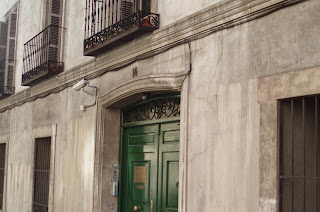
Walker in Court, I am a regular, for many years, this roundabout and I attended their transformations over the past forty years, with the disappearance of the dreadful blessed overpass ("Scalextric"), the most unfortunate of the old San Antonio market and changes in commerce, communications, transport and urban infrastructure.
Despite the changes, but needed some than others, those nostalgic for a past time we could always take comfort in the contemplation of two landmark buildings in the square "of a lifetime": the former Home Relief and Public School Cervantes.
The former home of Socorro, which operated until the mid-seventies of last century, is a small two-story pavilion, designed in brick, in a style you might call neomudéjar without fanfare. Originally, depended on the Municipal Charity and was designed to cater for minor injuries and first aid for those who need such aid. It was built around 1900 by local architect Paul Aranda on land donated by the Marquis of Aguilar de Campo. Embracing
sided building that is the last corner of Calle de Santa Engracia and Raimundo Fernandez Villaverde, are the two wings of the building of the school "Cervantes", building a little later (1910) and highlighting a graceful torreoncillos outside surrounding a central courtyard. Its author was the famous architect Antonio Flores Urdapilleta (Vigo 1877-Madrid 1941) who, as director of the School Construction Technical Office, Ministry of Education promoted the construction of numerous schools in Spain. These appendices, which occupy a larger area than the corner flag (the old House of Relief) " are designed, also massive brick and keeping the stylistic harmony with the previous work, but with even greater simplification of ornamental " 1.
During the past few months we saw work being carried out inside the flag of the former Casa de Socorro and on its roof, covered with canvas, stood a strange structure, in our naivety and ignorance of the branch public works, attach to a modern scaffolding dismantled upon completion of those.
our surprise, wonder and amazement have been great, when these days have been "uncovered" the work and challenge friends and strangers, to stand on the roof of the venerable hall neomudéjar, silhouetted against the sky, an aluminum and glass mazacote which know but whose aesthetic value is attacking us and angry to the point of offering readers of this blog, which is not specifically report, the accompanying photos are clear testimony of this blatant attack urban, environmental and historical against the people of Madrid munícipes irresponsible taken with malice aforethought.


I hope some historian of the town and many locals anonymous, in the light of this monstrosity, do hear a strong protest against this outrage, for improved visibility, can not go as unnoticed as the demolition of the house Bath, Bravo Murillo street, another great initiative of this Boeotian municipality that governs us.

February 2011
NOTES
1. " Madrid Cuatro Caminos (a suburb workers)". Tours Teaching in Madrid 8. City and Education Group: Ramón Hidalgo Monteagudo. Rosalia Ramos Guarido. Fidel González Revilla. 1990 Editions Bookstore




















